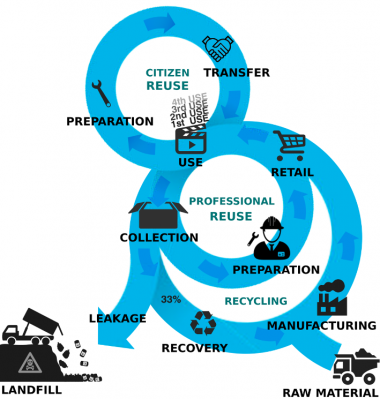The terms recycling and reuse are often used as synonyms, but this is incorrect “Recycle” refers to the process in which a raw material is used again to create something new. “Reuse” means using a product or its components again for the same purpose or finding another use for the item: What is the reuse of electronics?
The concept of a circular economy can become very elastic. Its meaning can vary drastically depending on the interests of the person who defines, uses, and implements it. For example, it is considered circular to burn waste for the generation of energy. If accepted, will the burning of a product that could have been reused continue to be considered circular? What is circular electronics?
The entities federated to ereuse.org refurbish and resell used devices such as mobiles, laptops or desktops. These members also create open, local and autonomous reuse platforms that bring automation, traceability and auditability in all the steps in the lifetime of devices with the aim of making electronics affordable, durable and impact accountable. What is an electronics reuse circuit?
What is electronics reuse?

The reuse of electronic devices such as desktops, laptops or mobile phones is applied to devices that have already been manufactured and are no longer in use (disposal) and will be recycled unless they are refurbished /reconditioned (repaired, upgraded) and used again or redistributed to other users.
We say a device or component is reusable if it has or may have use value for someone:
- If the device’s use value is high enough, it means that there is somewhere a potential user for it as it is, and only a basic refurbishing process is required, such as erasing data or restoring the operating system (this is represented as a citizen reuse loop in the next figure).
- If the use value is too low, it can be increased through several types of refurbishment actions: repairing, replacing damaged components, and updating/upgrading (this is represented as a professional reuse loop in the next figure).
The reuse process ends when, after a few years, the device or component reaches a disposal state, which means its use value, then, or through potential improvements, does not allow its reuse again. The cycle then reaches recycling to recover (reuse) raw materials and manufacture new components.
What is circular electronics?
The circular economy is an ideal way to change the current consumption model based on buy, use, and throw away. A circular economy in electronics aims to preserve in use the products and components that have already been manufactured and recover raw materials when devices are no longer repairable and functional.
Circularity means creating a self-sufficient system that does not require inputs of raw materials and does not have losses. Losses are waste that ends up in landfills where materials cannot be recovered.
In a circular economy, products and materials are seen as assets, and businesses are seen as users who should repair, upgrade, and reuse their devices and materials to maintain them in use as much as possible.
We aim at a circular economy in which all viable reuse processes are performed until the use value of devices does not allow further reuse, and any reused device is recycled at the end.
Therefore, three principles are key to achieving circular electronics: reduce, reuse, and recycle. We should ensure that devices have low use value when they are recycled so there is no premature recycling.
What is an electronics reuse circuit?
In cities, federated members and city councils collaborate and coordinate in reuse circuits with great effect in creating inclusive jobs, starting or accelerating efficiency and scaling up of local exchange/market of second hand devices. City councils deliver IT retired equipment to local reuse centers that are circular economy impact accountable and collaborate between them to increase reuse and recycling.
There are two levels of circuits: the first level only includes reuse centers; at this level each actor has its own federated platform, looks for its equipment supply funds and establishes its collaboration agreements between other reuse centers and resellers. In the second level (collaborative), there is a zero waste entity that acts as an umbrella of the reuse centers.
Collaborative Circuits establishes an agreement between reuse centers and resellers to manage, share and maintain the circularity of digital devices and seek collaboration rather than competition. The mission of a collaborative Circuit is to promote cooperation between entities in the reuse sector and the responsible, collaborative and circular use of digital devices.